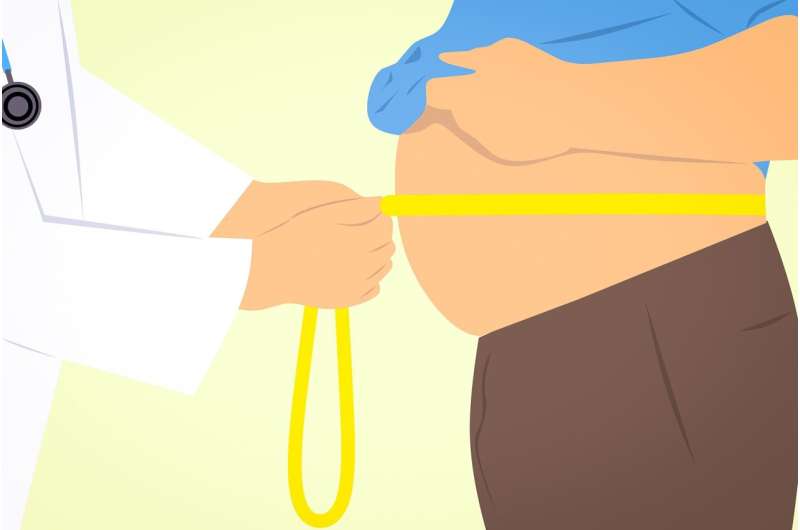This article has been reviewed according to Science X's editorial process and policies. Editors have highlighted the following attributes while ensuring the content's credibility:
fact-checked
peer-reviewed publication
trusted source
proofread
New study explains why people with obesity are at a higher risk of developing cardiovascular disease

Obesity is a public health problem worldwide that currently affects more than 40% of adults in the U.S. Alarmingly, more than 9% of the U.S. population had severe (Class 3) obesity in 2020, the highest designation with a weight of 271 pounds or more for a person 5'9" and body mass index (BMI) of 40 or greater. Obesity is on the rise and is a major risk factor for cardiovascular disease (CVD), diabetes and certain cancers.
Obesity often involves hyperlipidemia (high concentrations of fats/lipids in the blood), diabetes, hypertension, chronic inflammation and oxidative stress, which increase susceptibility to CVD.
Low-density lipoprotein (LDL) is a nanoparticle that transports cholesterol in blood. Cholesterol, which is good in moderation, is essential for normal cellular function. However, excess cholesterol can deposit in arteries causing CVD, and hence LDL cholesterol is dubbed "bad cholesterol." In a new study, Boston University Chobanian & Avedisian School of Medicine researchers have discovered that in obesity, LDL becomes does not function normally increasing the risk of CVD.
"Our results showed that in obesity, it is not the quantity but the quality of LDL that contributes to disease: 'bad cholesterol' becomes worse due to obesity-associated inflammation. As a result, cholesterol delivery is shifted from normal to abnormal, so more cholesterol is retained in the arterial wall, ultimately forming plaques that occlude the blood flow," explained corresponding author Shobini Jayaraman, Ph.D., a senior research scientist in pharmacology, physiology and biophysics.
In the study, blood lipoproteins from patients with severe obesity before bariatric surgery and 6 or 12 months after were compared with lipoproteins from a control group of lean healthy subjects. The researchers then explored lipoprotein interactions with three cell receptors key to LDL function. This included LDL receptor (which directs normal uptake of cholesterol by cells) and two scavenger receptors (which can cause harmful cholesterol accumulation).
They then designed an assay to quantify lipoprotein interactions with many extracellular matrix components. These interactions can promote harmful lipoprotein retention in the arteries, which can cause atherosclerosis. Additionally, they analyzed LDL composition and used liquid chromatography and other biochemical methods to explore nanoparticle charge and aggregation, which influence LDL functionality.
In patients with obesity, they found LDL particles became dysfunctional and were less efficient at delivering their cholesterol cargo to LDL receptors. Additionally, the LDL particle also tended to either preferentially deliver cholesterol to scavenger receptors or stick to the arterial wall matrix. "This aberrant behavior stemmed from alterations in LDL biochemical composition induced by obesity-associated inflammation. These harmful changes contributed to increased risk of CVD in patients with obesity," added Jayaraman.
According to the researchers, during the first year after the bariatric surgery the patients lost a lot of weight, the obesity-induced inflammation subsided, and the LDL quality progressively improved 6 and 12 months post-operatively. Still, the LDL quality did not reach the levels of lean controls and neither did the BMI. However, LDL quality clearly correlated with weight loss—the closer the patient's weight was to normal, the better was their LDL quality, resulting in a lowered risk of CVD.
"Our study shows that LDL quality continues to improve as a patient's weight normalizes, suggesting that the risk of CVD continues to decline. This is promising not only for patients undergoing bariatric surgery but perhaps for many others who are overweight or obese and use various approaches to weight loss," said senior author Olga Gursky, Ph.D., professor of pharmacology, physiology and biophysics at the school.
All clinical and some biochemical studies were performed by the Barcelona team led by Dr. Jose Luis Sanchez Quesada, the co-corresponding author on this study.
These findings appear online in the Journal of Lipid Research.
More information: Shobini Jayaraman et al, LDL binding to cell receptors and extracellular matrix is proatherogenic in obesity but improves after bariatric surgery, Journal of Lipid Research (2023). DOI: 10.1016/j.jlr.2023.100451




















